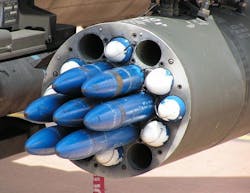Navy asks BAE Systems to upgrade guidance system of APKWS laser-guided rockets for helicopters and planes
PATUXENT RIVER NAS, Md. – The U.S. military is upgrading laser-guided rockets that enable fixed-wing aircraft, helicopters, and unmanned aerial vehicles (UAVs) to attack lightly armored vehicles, bunkers, field fortifications, cars, and trucks with electro-optical smart munitions.
Officials of the U.S. Naval Air Systems Command at Patuxent River Naval Air Station, Md., announced a $10.9 million order Wednesday to the BAE Systems Electronic Systems segment in Hudson, N.H., to upgrade of the Advanced Precision Kill Weapon System (APKWS) guidance section.
APKWS is an add-on kit that turns a standard unguided 2.75-inch 70 millimeter rocket into a precision laser-guided munition to give warfighters a low-cost surgical strike capability, BAE Systems officials say. Typically the kit fits on the Hydra 70 fin-stabilized unguided air-to-ground rocket.
The order asks BAE Systems to combine separate guidance sections for the APKWS II intended for helicopters and fixed-wing aircraft into one hardware and software solution. The APKWS II uses semi-active laser-guidance for U.S. military and allied military aircraft.
APKWS uses semi-active laser-guided technology to strike soft and lightly armored targets in confined areas, it has provided the U.S. Marine Corps with a 93 percent hit rate. It is smaller and less expensive than comparable laser-guidance missiles like the AGM-114 Hellfire.
The APKWS laser-guided precision munition can fit aboard the U.S. Marine Corps UH-1Y, AH-1W, and AH-1Z helicopters, the experimental Bell 407GT helicopter, the U.S. Army AH-64 Apache attack helicopter, the Eurocopter Tiger, and the Navy MH-60 Seahawk helicopter.
The system also fits aboard fixed-wing aircraft such as the AV-8B Harrier II, F-16 jet fighter, and A-10 close-air-support jet.
In the future the APKWS is under consideration for the Navy MQ-8 Fire Scout unmanned helicopter, OH-58 helicopter, V-22 tiltrotor, AH-6 Little Bird helicopter, the A-29 Super Tucano ground-attack aircraft, and the Navy F/A-18E/F fighter-bomber.
The APKWS-equipped rocket is slightly longer than six feet, 2.75 inches in diameter, has a wingspan of 9.55 inches, and weighs 32 pounds. It uses the Hydra 70 impact-detonating, air-burst, or standoff warheads. The laser munition can hit targets as far away as three miles, and flies at speeds of 2,200 miles per hour.
On this order BAE Systems will do the work in Hudson, N.H., and Austin, Texas, and should be finished by April 2021. For more information contact BAE Systems Electronic Systems online at www.baesystems.com, or Naval Air Systems Command at www.navair.navy.mil.
Ready to make a purchase? Search the Military & Aerospace Electronics Buyer's Guide for companies, new products, press releases, and videos

